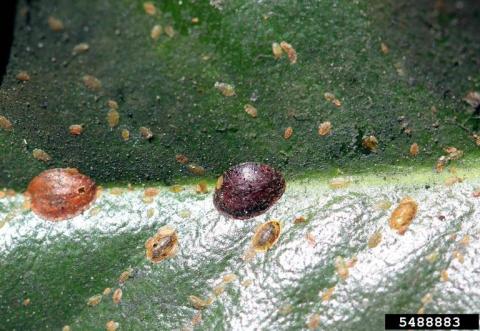How can I get rid of brown soft scale on my bay laurel?

Scale insects can be incredibly frustrating and difficult to manage. They are immobile for most of their life cycle and often avoid detection when their numbers are low. Brown soft scales appear as small, flat, oval, yellowish brown bumps on the stems and leaves of houseplants. Brown soft scales feed on plant sap with piercing-sucking mouthparts and excrete a sweet, sticky fluid called honeydew. Unsightly black fungus called sooty mold often grows on the honeydew, making the leaves look dirty and reducing photosynthesis. Heavy scale infestations can reduce plant vigor and stunt growth.
Instead of laying eggs, female scale insects give birth to live young called “crawlers”, which are the only mobile life stage. As the crawlers molt into adults they stop moving and develop shell-like, waxy, outer coverings that conceal and protect their bodies. The crawler stage is most vulnerable to treatment, although it is often difficult to predict when they will be active. Multiple treatments may be necessary to fully eliminate an infestation.
It is often best to discard heavily infested plants rather than try to treat them. If your plant is only lightly affected, you can try washing the leaves and stems with a diluted dish detergent and water solution. Use a cloth or a brush to remove both the scale insects and the honeydew from the leaves. Handpicking or using a Q-tip dipped in alcohol may also be effective. If you haven’t gotten control after multiple treatments, a number of houseplant insecticides are registered for use on scale insects. If you use an insecticide, make sure you read and follow the label carefully before using the material.
Picture credit: Whitney Cranshaw, Colorado State University, Bugwood.org
Got questions? The Ask UNH Extension Infoline offers practical help finding answers for your home, yard, and garden questions. Call toll free at 1-877-398-4769, Monday to Friday, 9 a.m. to 2 p.m., or e-mail us at answers@unh.edu.